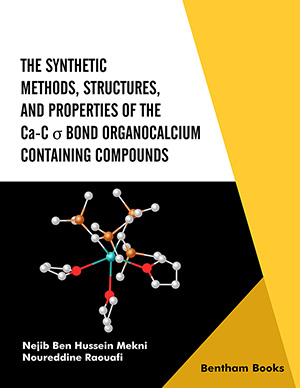Abstract
SHS investigation development is considered from the geographical and historical viewpoint. 3 stages are described. Within Stage 1 the work was carried out in the Department of the Institute of Chemical Physics in Chernogolovka where the scientific discovery had been made. At Stage 2 the interest to SHS arose in different cities and towns of the former USSR. Within Stage 3 SHS entered the international scene. Now SHS processes and products are being studied in more than 50 countries.
Abstract
Compared to other organometallics, the number of organocalcium
compounds and their related publications are limited. In this chapter, we grouped
different Ca-Cσ-bond containing organocalcium compounds described in the literature,
(Alkyl, silyl, cycloalkyl, benzyl, alkenyl, alkynyl, diene, diyne, phenyl, biphenyl,
anthracene, halo thiophene and picoline derivatives) with the specificity for each kind
of compounds. We discuss the stabilizing factors of structures including: conjugation,
hyperconjugation, complexing heteroatom lone pairs and π-bonding electron pairs.
The different synthetic processes used to avoid synthetic problems of substrate and
calcium source reactivity, intermediate and product stability and solubility, reaction
temperature, yields and decomposition reactions of both intermediates and products, as
well as the orientation of the reaction sides in some reactions, are also grouped
(thiophene and picoline derivatives).
The halo aromatic organocalcium compounds are described to be the most stable
intermediates, giving the best yields.
Some calculations that correlate with experimental results are mentioned. Particular
calcium reagents, such as Ca*, CaI2
and particular reactions as well as exchange
(transmetalation) reactions are also examined.
Some examples of the geometrical structures, which give C-Ca-C bent angles, and
bond lengths obtained from X-ray are gathered.
Keywords:
Activated calcium, Calcium complexes, Calcium coordination, Calcium derivatives, Calcium halides, Calcium halo intermediates, Calcium insertion reaction;, Calcium-Carbon bent angle, Calcium-Carbon σ-bond, Direct and indirect synthesis, Ethereal coordination, Ethereal medium, Exchange reaction, Ipso-carbon atom, Metathesis reaction, Organocalcium complex, Organocalcium degradation, Organylcalcium, Schlenk equilibrium, Transmetalation.
We recommend

Authors:Bentham Science Books






